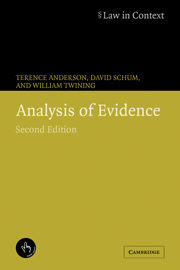Book contents
- Frontmatter
- Contents
- Preface
- Acknowledgments
- Tables of cases and statutes
- Table of legislation and rules
- List of abbreviations
- 1 Evidence and inference: some food for thought
- 2 Fact investigation and the nature of evidence
- 3 Principles of proof
- 4 Methods of analysis
- 5 The chart method
- 6 Outlines, chronologies, and narrative
- 7 Analyzing the decided case: anatomy of a cause célèbre
- 8 Evaluating evidence
- 9 Probabilities, weight, and probative force
- 10 Necessary but dangerous: generalizations and stories in argumentation about facts
- 11 The principles of proof and the law of evidence
- 12 The trial lawyer's standpoint
- Glossary of terms and symbols
- References
- Index
5 - The chart method
Published online by Cambridge University Press: 23 November 2009
- Frontmatter
- Contents
- Preface
- Acknowledgments
- Tables of cases and statutes
- Table of legislation and rules
- List of abbreviations
- 1 Evidence and inference: some food for thought
- 2 Fact investigation and the nature of evidence
- 3 Principles of proof
- 4 Methods of analysis
- 5 The chart method
- 6 Outlines, chronologies, and narrative
- 7 Analyzing the decided case: anatomy of a cause célèbre
- 8 Evaluating evidence
- 9 Probabilities, weight, and probative force
- 10 Necessary but dangerous: generalizations and stories in argumentation about facts
- 11 The principles of proof and the law of evidence
- 12 The trial lawyer's standpoint
- Glossary of terms and symbols
- References
- Index
Summary
The chart method: an overview
The chart method of analysis is the most rigorous of the three methods of analysis identified above. It is a technique that enables the analyst to construct, test, and reconstruct arguments about questions of fact. It requires that the analyst articulate every step in an argument, breaking down the argument into simple propositions, and then mapping or “charting” all the relations between those propositions and the penultimate probanda (or the components of a hypothesis). The logic is simple; the complexity lies in the materials to be analyzed and in identifying the relationships between the propositions in an extensive argument based on a mass of conflicting evidence. The logic is binary: Every relevant proposition either tends to support or tends to negate a single hypothesis or conclusion (the ultimate probandum). The technique is dialectical: The aim of the chart-maker should be to construct the most cogent possible argument for and against the ultimate conclusion and to relate the opposing arguments within a single coherent structure.
The chart method structures the analysis at two levels – the macroscopic level and the microscopic level. The macroscopic level involves structuring the “top” of the chart. The ultimate and penultimate probandamust be determined based upon the law and, usually, restated after the analyst has formulated a provisional theory of the case. The penultimate probanda help the analyst identify which of the main propositions must be established to support each of the penultimate probanda.
- Type
- Chapter
- Information
- Analysis of Evidence , pp. 123 - 144Publisher: Cambridge University PressPrint publication year: 2005



